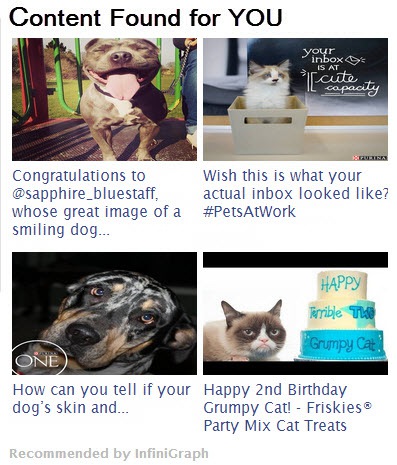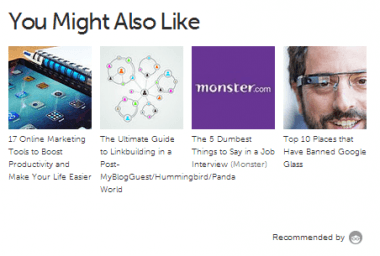 Content recommendation “widgets” are hot and taking off. Brands are now seeing the benefits of surfacing their own content in this intelligent format. Photo / InfiniGraph
Content recommendation “widgets” are hot and taking off. Brands are now seeing the benefits of surfacing their own content in this intelligent format. Photo / InfiniGraphBrands are missing a big opportunity to close the “social loop” and “frack” their owned content.Advanced technologies using learning algorithms, content recommendations and visual content platforms are powering top publisher sites today to help connect readers with content they will love. However, the void of discovery and targeting of brands content creates a big problem. A great example of fracking is in the oil and gas business using a technology called hydraulic fracturing i.e. “fracking”, to extract trapped resources deep in the earth. Brand need to frack their own content resources locked up on their social, websites, community sites, and blogs.
With the drop in Facebook news-feed views and the explosive growth of content recommendation solutions, like Ourtbrain, means every nickel spent on conversions better maximize your content assets. It’s nothing new that brands are experiencing social feed collapse and standing out in a noisy environment is getting harder. Most of your content is getting lost in the shuffle. Recycle it! Let the customer’s social activity tell you what they prefer. Engagement in social is good, but not if that’s all you get. Some top brands have made the transition to acting like publishers with dedicated internal and external teams cranking out content.
A great example of this type of merger is Complex Media and Mountain Dew launch of Green-Label.com, a lifestyle site that publishes a wide range of content. How does a brand compete with this level of resources and a mechanized content arsenal? Brands have turned to marketing automation tools (Exact Target and Marketo to name a few), publishing technologies, and content teams like Contently, all of which are being used to level the playing field and stay relevant.
Top tactics used by savvy publishing brands are:
- Storytelling – high quality engaging content on an going basis
- Infographic Creation – relevant lists and how to’s
- Visual Content Marketing – compelling visuals
- eBook Creation – great for lead generation
- eMailer Personalization – targeting with relevance and being the information / education source
- Content Curation within an Industry – keep people coming to you because you find what’s hot and important to your customers, making it easy for them to keep current
- Webinars / Pod Casts / Google Hangouts – establishes authority
- Slide Share Presos – extends your corporate social graph and thought leadership
- Case Studies – SEO value and high share currency
- Videos to Motion Infographics — video is growing
Even if you have a lean, mean, content creation machine, you still need to drive amplification to drive sales. Not only promotion, but full on recycling the content in many forms, getting the most out of your content assets. The hard job is creating more content to stay relevant with your customers and educating them as part of a sales process. The “How to’s” and infographics, along with rich storytelling are all being used by the leaders. making it harder for the competition to keep up.
Smart Content Routing
 “You Might Also Like” is a great recommendation widget found on Search Engine Journal posts. See at bottom of this post what Outbrain is promoting and found on many other publisher pages Photo / Chase McMichael
“You Might Also Like” is a great recommendation widget found on Search Engine Journal posts. See at bottom of this post what Outbrain is promoting and found on many other publisher pages Photo / Chase McMichaelBrands have a need for smart content routing and unique displays which enable them to maximize customer engagement and experience at every touch point, increasing site participation, and garnering higher social share just begs to get fracked. Many brands only change their static websites, blogs, and even eCommerce sites when a product update occurs. Brands must embrace customer driven publishing techniques to scale their own engagement and utilize intelligence to drive higher call to action responses. There are several examples of content recommendation and discovery platforms. You may have seen them on bottom or right sides of sites, labeled “Sponsored”, “Content Found for You”, or “You Might Also Like”.
Publishers are doing everything they can to maximize their digital real estate and revenue, and so should you. For most brands, these advanced visual content display solutions are nonexistent. Yes, there are WordPress and social plugins that show popular content and the most engaged content, however, most of these lack intelligence and cohesive management over many pages. They also don’t usually address partner sites. Closing the social loop requires giving a readers the ability to discover what other content people are engaged with.
Content Recommendation Platforms
Companies like Outbrian, Taboola and Zemanta all provide content fracking techniques over some of the biggest publishing networks. Here is a list of the top platforms, ranked by market share (based on LeadLedger analysis).
- OutBrain
- Taboola
- NRelate
- Zemanta
- Disqus
- Scribol
- ShareThrough
Each of these companies uses different methods to distribute content on a pay per click model. It’s unclear how intelligent these systems are and some provide static content on many sites, making it appear they are providing a true pay for placement model, unlike Google that requires the source to be of a specific, measured quality. Outbrain, for one, its not a pure ad and directs visitors to relevant content.
Going beyond content recommendation to full site personalization is now possible. Companies like Marketo and Gravity use reader’s interest graph linked with news sites and time sensitive content are showing promising results. This is not new, but technology and big data is starting to create innovative ways to serve content. All these examples are still in their early stages of expanding services to the evergreen publishing space.
Data Intelligence and Learning Algorithms
There are many technologies in the market that surface and assist in curating content, scoring, and ranking various content. Most of this content discovery has very little intelligence and doesn’t necessarily understand what the consumer’s content preferences are. Technologies like Yahoo Pipes, a very slick filtering and mashup tool, allows you to create your own service to fetch search results from Yahoo, Bing, Google, and Flickr (and others) to find people and content.
ContentDJ is very useful for finding interesting content to share on Twitter and Facebook. It ranks tweets in any niche (searchable using hashtags and/or keywords) through an algorithm based on what was shared the most.
Trapit is also a great tool for content discovery, using an algorithm that incorporates the same Natural Language Processing technology found in Apple’s Siri. As the text is being processed, it will try to cross match to other content with a human system of vetting content.
A similar service, that is not exactly on the web (it is only available as an iOS Application), is Zite. Much like Trapit, Zite follows topics of your choice and delivers very relevant suggestions. Trapit is similar to My6Sense — it’s sort of like an RSS reader, but it provides a unique way to follow topics. Similar to My6Sense, it learns from your feedback. Unlike My6Sense, it is available on PCs and Macs — My6Sense is available only as an iOS/Android app.
Summly, purchased by Yahoo and later to become Yahoo News Digest, is another content recommendation application. There’s also News360 available on all platforms. For a brand, this same technology needs to be implemented for their own content to learn what their customers engage with and push content recommendation to the points where they are active on their sites.
Closing the Social Loop
 Visual of releasing the content trapped below “Fracking” your content marketing and closing the social loop Photo / Cracked Earth: Creative Commons Matt Rudge
Visual of releasing the content trapped below “Fracking” your content marketing and closing the social loop Photo / Cracked Earth: Creative Commons Matt RudgeClosing the social loop on your own content is critical to maximizing site “stickiness” and frack your own content. It’s not new to recommend to people purchasing one item that these other items were purchased or searched on. Amazon and Ebay were among the first to exploit this technique with great success. There are many eCommerce applications doing intelligent recommendation as well so why not do this with your own content? LinkedIn now has the ability to display scoring for searches on your profile and now shows content reach.
Visual curation products are fast becoming a commodity, however, intelligently routing relevant content to strategic places on your site or integrated directly in your e-commerce sites, purchase exit pages, and mailers creates a more meaningful experience. You have a captivated customer so put your best foot forward with your best content. Keep in mind, the majority of people don’t see the majority of content.
Advanced learning algorithms are used to predict what content should be shown to increase the probability of you clicking through. Most brand websites and blogs don’t consider their social channels as the barometer to what’s relevant. Agencies and digital managers buy traffic to drive engagement to the promoted posts or calls to action, then what? What are they doing on your sites to keep that valuable new customer or existing customer engaged? With the explosion of content marketing and content as a weapon, brands are sitting on massive incarcerated assets that require liberating. A more sophisticated approach is required to stay competitive.
Fracking Your Content Marketing
Digital marketing teams and agencies pay for content discovery platforms to drive traffic to a page to show content traction and conversion to back up the KPI. This can be a big problem for brands who don’t understand why they need to close the Social Loop. Most websites don’t change their content that often, usually just the company’s blog or community content and most certainly social content. Some brands the volume and quality in a highly competitive business requires steady updates. The fragmented messages and lack of continuity is where your customers are falling through the content marketing cracks. Brands acting as publishers need advanced content routing and display technologies to give the customer the same experience they are obtaining on successful publishing sites. Here are 10 ways to consider maximizing your content assets to get more out of your valuable resources.
Understand Traffic:
- Use the data, don’t just create reports
- If you see a page or post getting traction reorganize your content, re-post on other pages
- Create a feature section and show how much engagement the content obtained
Social Engagement
Measure engagement, don’t just track it (this great list of tool by KISSMetrics is a great place to get started: 25 Sneaky Online Tools to Spy on Your Competitors). Leverage the data to show content that’s important to others and be sure to take advantage of people being on your page.
Google Events Flow
Google event flow tracks the path people take on your site. It can identify where they drop off and provide the ideal place to place content recommendation. Bring forth your most trending content in a visual way and see if you can route people back into your site.
Recommend Content
Surface content people engage with the most and keep it changing. Don’t just show some side bar on the bottom of your page “Related Content” or sunk in a multi-tab interface, hiding the most engaged. Make it visual with images! The more it stands out the more traffic you will get.
Monitor Clicks
Watch your recommended content performance and promote it on your home page. Make a big deal about it. Show it on your blog, mailers, and purchase exit pages. Even put it in purchase confirmation emails.
Cross Promote
Cross promoting top content is critical to extend your reach. Make sure top content is integrated in to your Marketing Automation strategy along with re-posting over your social channels. You can always purchase or place your best content on the cost per click networks but be careful that you match that network audience with your content relevance.
Position Content
Link your best content where your customers are visiting...recycle!! On each page of your site, not just via a WordPress plugin. Use visuals in strategically placed areas where your customers are dropping off. Create a plan to update this weekly or monthly and integrate it as part of your content calendar process.
Email Integration
Email marketing is still effective. Exact Target and many other marketing automation platforms support XML content feeds so use them. Feed in your best trending content to create additional discovery and interaction. This is simple to measure shows what’s working and it can create hyper discovery.
eCommerce Integration:
Purchase thank you pages are another key integration point. What is on your thank you page now? Content recommendation brings them back to your site versus just telling them what they ordered.
Hyper Discovery
Are you fracking your content by inserting topical trends or your most engaged content on your site? Any curation platform will provide access to other content that’s relevant to your industry, but you need to apply intelligence to make achieve dynamic relevance. If you’re not the source of discovery, your competitors will be — and you will have missed an opportunity to be the content magnet with in your own industry. Your customer is trained to engage with Pinterest, Instagram, and Tumbler so be smart and deploy a Content Hub. These visual content platforms create Hyper Discovery, making it easy to share and engage, bringing new customer to your site. They also present unique opportunities for email capture and other e-commerce integration points.
Incarcerated content is a problem, but new techniques are allowing brands to find ways to liberate their assets. Customers are overloaded and don’t have time to sift through every article on your site. Closing the social loop will increase website engagement, time on the site, and both brand engagement and social engagement while keeping them close to your bottom-line. Brands have a major opportunity to help customers discover great content and maximize site experience while developing a unique data set to show what content is getting referral traffic and higher share due to internal discovery.
What discovery platforms and solutions are you using to make your site more engaging and dynamic?





